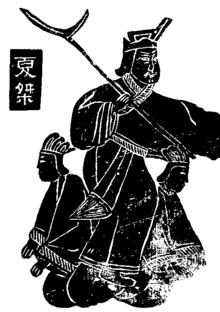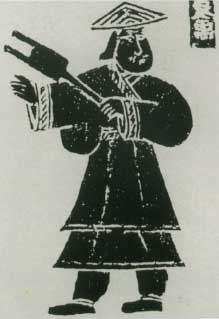Stone carvings in the tombs of the Wu family in Jiaxiang
The stone carvings in the graves of the Wu family in Jiaxiang ( Chinese 嘉祥武 氏 墓群 石刻 , Pinyin Jiāxiáng Wǔ shì mùqún shíkè or 武氏 祠 画像 , Wǔshì cí huàxiàng , English Stone Carvings at Wu's Tombs in Jiaxiang ) are also in the Chinese district of Jiaxiang known as the stone carvings of the Wuliang Ancestral Temple ( 武 梁 祠 画像 , Wǔliáng cí huàxiàng , English Wuliang Ancestral Temple ). They come from the Eastern Han period and were rediscovered in the Song Dynasty (960-1279). These include que (stone towers), steles, stone lions, tombstones, portraits and inscriptions.
They are already attested in the works Jinshi lu (catalog of the inscriptions on bronze and stone) of the epigrapher Zhao Mingcheng 赵明诚 (1081–1129) and in the Jigu lu (report on collected antiquities) of the writer Ouyang Xiu . Later, the stone grave rooms were inundated by several floods.
Thematically, the portraits of the steles cover a broad spectrum: legendary personalities such as the Three Sovereigns ( Sanhuang ): Fuxi together with his female counterpart Nüwa ; Zhurong ; Shennong (the "Divine Peasant") tilling the land with a spade in hand ; the Five Emperors ( Wudi ): Huangdi (the Yellow Emperor), Zhuanxu , Ku , Yao and Shun ; Xiayu (the Great Yu of the Xia Dynasty), who led his people to build canals, and the tyrannical Emperor Jie of the Xia Dynasty, sitting on two ladies-in-waiting with a halberd on his shoulder; Images of loyal men fulfilling their duties as children; popular historical stories such as Cao Mo 曹沫 , who assassinated Duke Huan of Qi ; Zhuan Zhu , who assassinated King Liao of Wu ; Jing Ke , who assassinated China's First Emperor Qin Shihuang , and so on.
Furthermore, the images provide a wealth of stories from mythology and fairy tales, scenes of festivals, hunts, horse-drawn carts, travel, fighting, etc. They contain ample historical information about the social conditions, local customs, religion and culture of the Eastern Han Dynasty .
They have been on the list of monuments of the People's Republic of China (1-55) since 1961 .
literature
- Cary Y. Liu, Michael Nylan, Anthony Barbiere-Low (eds.): Recarving China's Past. Art, Archeology, and Architecture of the “Wu Family Shrines”. New Haven & London, Princeton University Press 2005
- Wu Hung: The Wu Liang Shrine: The Ideology of Early Chinese Pictorial Art . Stanford: Stanford University Press 1989
Web links
Footnotes
- ↑ The site is also called Wushi shici ( 武氏 石 祠 , Wǔshì shící ) in Chinese .
Coordinates: 35 ° 16 ′ 59.1 ″ N , 116 ° 20 ′ 51.3 ″ E

